Red Mud Potentially Alleviates Ammonia Nitrogen Inhibition in Swine Manure Anaerobic Digestion by Enhancing Phage-Mediated Ammonia Assimilation
Abstract
1. Introduction
2. Materials and Methods
2.1. Materials
2.2. Anaerobic Digestion Experiments
2.3. Analytical Methods
2.4. Viral DNA Extraction and Sequencing
2.5. Viral Contig Assembly, Identification, and Host Prediction
2.6. Taxonomic Assignment and AMG Annotation of Phages
2.7. Statistical Analysis
3. Results and Discussion
3.1. Impacts of Red Mud on Methane Production and Nitrogen Metabolism
3.2. Community Structure and Diversity of Microbes
3.3. Composition and Evolution of Viral Community
3.4. Phage-Encoded AMGs Enhanced Anaerobic Digestion and Ammonia Assimilation
3.5. Phage–Host Linkage Analyses
4. Conclusions
Supplementary Materials
Author Contributions
Funding
Institutional Review Board Statement
Informed Consent Statement
Data Availability Statement
Acknowledgments
Conflicts of Interest
References
- Satchwel, A.J.; Scown, C.D.; Smith, S.J.; Arnirebrahimi, J.; Jin, L.; Kirchstetter, T.W.; Brown, N.J.; Preble, C.V. Accelerating the Deployment of Anaerobic Digestion to Meet Zero Waste Goals. Environ. Sci. Technol. 2018, 52, 13663–13669. [Google Scholar] [CrossRef] [PubMed]
- Yan, M.; Treu, L.; Zhu, X.Y.; Tian, H.L.; Basile, A.; Fotidis, I.A.; Campanaro, S.; Angelidaki, I. Insights into Ammonia Adaptation and Methanogenic Precursor Oxidation by Genome-Centric Analysis. Environ. Sci. Technol. 2020, 54, 12568–12582. [Google Scholar] [CrossRef] [PubMed]
- Zhang, R.C.; Anderson, E.; Addy, M.; Deng, X.Y.; Kabir, F.; Lu, Q.; Ma, Y.W.; Cheng, Y.L.; Liu, Y.H.; Chen, P.; et al. An innovative intermittent-vacuum assisted thermophilic anaerobic digestion process for effective animal manure utilization and treatment. Bioresour. Technol. 2017, 244, 1073–1080. [Google Scholar] [CrossRef]
- Rajagopal, R.; Massé, D.I.; Singh, G. A critical review on inhibition of anaerobic digestion process by excess ammonia. Bioresour. Technol. 2013, 143, 632–641. [Google Scholar] [CrossRef] [PubMed]
- Shanmugam, P.; Horan, N.J. Optimising the biogas production from leather fleshing waste by co-digestion with MSW. Bioresour. Technol. 2009, 100, 4117–4120. [Google Scholar] [CrossRef]
- Jiang, Y.; McAdam, E.; Zhang, Y.; Heaven, S.; Banks, C.; Longhurst, P. Ammonia inhibition and toxicity in anaerobic digestion: A critical review. J. Water Process Eng. 2019, 32, 100899. [Google Scholar] [CrossRef]
- Xiao, Y.Q.; Yang, H.N.; Zheng, D.; Liu, Y.; Deng, L.W. Alleviation of ammonia inhibition in dry anaerobic digestion of swine manure. Energy 2022, 253, 124149. [Google Scholar] [CrossRef]
- Wittmann, C.; Zeng, A.P.; Deckwer, W.D. Growth inhibition by ammonia and use of a pH-controlled feeding strategy for the effective cultivation of Mycobacterium chlorophenolicum. Appl. Microbiol. Biot. 1995, 44, 519–525. [Google Scholar] [CrossRef]
- Yang, J.; Guo, Z.; Al-Dhabi, N.A.; Shi, J.; Peng, Y.; Miao, B.; Liu, H.; Liang, Y.; Yin, H.; Liu, X.; et al. The succession of microbial community and distribution resistance gene in response to enrichment cultivation derived from a long-term toxic metal(loid)s polluted soil. Sci. Total Environ. 2024, 954, 176385. [Google Scholar] [CrossRef]
- Fotidis, I.A.; Karakashev, D.; Angelidaki, I. The dominant acetate degradation pathway/methanogenic composition in full-scale anaerobic digesters operating under different ammonia levels. Int. J. Environ. Sci. Technol. 2014, 11, 2087–2094. [Google Scholar] [CrossRef]
- Khairul, M.A.; Zanganeh, J.; Moghtaderi, B. The composition, recycling and utilisation of Bayer red mud. Resour. Conserv. Recycl. 2019, 141, 483–498. [Google Scholar] [CrossRef]
- Ye, J.; Hu, A.; Ren, G.; Zhou, T.; Zhang, G.; Zhou, S. Red mud enhances methanogenesis with the simultaneous improvement of hydrolysis-acidification and electrical conductivity. Bioresour. Technol. 2018, 247, 131–137. [Google Scholar] [CrossRef] [PubMed]
- Ye, J.; Hu, A.; Ren, G.; Chen, M.; Tang, J.; Zhang, P.; Zhou, S.; He, Z. Enhancing sludge methanogenesis with improved redox activity of extracellular polymeric substances by hematite in red mud. Water Res. 2018, 134, 54–62. [Google Scholar] [CrossRef]
- Ye, J.; Hu, A.; Cheng, X.; Lin, W.; Liu, X.; Zhou, S.; He, Z. Response of enhanced sludge methanogenesis by red mud to temperature: Spectroscopic and electrochemical elucidation of endogenous redox mediators. Water Res. 2018, 143, 240–249. [Google Scholar] [CrossRef]
- Goloran, J.B.; Chen, C.R.; Phillips, I.R.; Liu, X. Transformation and plant uptake of 15N-labeled fertilizers mediated by ammonia-oxidizing bacteria in alkaline bauxite-processing residue sand amended with greenwaste compost. Ecol. Eng. 2015, 74, 68–78. [Google Scholar] [CrossRef]
- Shi, L.; Dong, X.; Liu, Z.; Yang, Y.; Lin, J.; Li, M.; Gu, J.; Zhu, L.; Zhao, H. A mixed blessing of viruses in wastewater treatment plants. Water Res. 2022, 215, 118237. [Google Scholar] [CrossRef]
- Wang, S.; Yang, Y.; Jing, J. A Synthesis of Viral Contribution to Marine Nitrogen Cycling. Front. Microbiol. 2022, 13, 834581. [Google Scholar] [CrossRef]
- Gazitua, M.C.; Vik, D.R.; Roux, S.; Gregory, A.C.; Bolduc, B.; Widner, B.; Mulholland, M.R.; Hallam, S.J.; Ulloa, O.; Sullivan, M.B. Potential virus-mediated nitrogen cycling in oxygen-depleted oceanic waters. ISME J. 2021, 15, 981–998. [Google Scholar] [CrossRef]
- Ahlgren, N.A.; Fuchsman, C.A.; Rocap, G.; Fuhrman, J.A. Discovery of several novel, widespread, and ecologically distinct marine Thaumarchaeota viruses that encode amoC nitrification genes. ISME J. 2019, 13, 618–631. [Google Scholar] [CrossRef]
- Liu, Z.; Huang, Y.; Zhang, T.; Meng, D.; Jiang, Z.; Yang, Z.; Yang, Z.; Li, L.; Gu, Y.; Wang, J.; et al. Viruses Regulate Microbial Community Assembly Together with Environmental Factors in Acid Mine Drainage. Appl. Environ. Microbiol. 2023, 89, e0197322. [Google Scholar] [CrossRef]
- Liu, Z.H.; Liang, Z.L.; Zhou, Z.C.; Li, L.Z.; Meng, D.L.; Li, X.T.; Tao, J.M.; Jiang, Z.; Gu, Y.B.; Huang, Y.; et al. Mobile genetic elements mediate the mixotrophic evolution of novel Alicyclobacillus species for acid mine drainage adaptation. Environ. Microbiol. 2021, 23, 3896–3912. [Google Scholar] [CrossRef] [PubMed]
- Karmakar, S.; Mukherjee, P.; Mishra, V.; Gupta, R.K.; Kumar, R.; Srivastava, P.; Sharma, R.S. Microhabitat influences on phage-bacteria dynamics in an abandoned mine for ecorestoration. J. Environ. Manag. 2024, 370, 122659. [Google Scholar] [CrossRef] [PubMed]
- Yu, Z.; Schwarz, C.; Zhu, L.; Chen, L.; Shen, Y.; Yu, P. Hitchhiking Behavior in Bacteriophages Facilitates Phage Infection and Enhances Carrier Bacteria Colonization. Environ. Sci. Technol. 2021, 55, 2462–2472. [Google Scholar] [CrossRef]
- Zhang, D.R.; Chen, H.R.; Xia, J.L.; Nie, Z.Y.; Zhang, R.Y.; Schippers, A.; Shu, W.S.; Qian, L.X. Red mud regulates arsenic fate at acidic pH via regulating arsenopyrite bio-oxidation and S, Fe, Al, Si speciation transformation. Water Res. 2021, 203, 117539. [Google Scholar] [CrossRef]
- Ma, Y.; Gu, J.; Liu, Y. Evaluation of anaerobic digestion of food waste and waste activated sludge: Soluble COD versus its chemical composition. Sci. Total Environ. 2018, 643, 21–27. [Google Scholar] [CrossRef]
- Ahmad, A.; Shahitha, F. The impacts of red mud dosing on methane production and reduction of CO2: Activity of granules and formation. Energy Environ. 2022, 33, 135–151. [Google Scholar] [CrossRef]
- Xu, R.; Kolton, M.; Tao, W.; Sun, X.; Su, P.; Huang, D.; Zhang, M.; Yang, Z.; Guo, Z.; Gao, H.; et al. Anaerobic selenite-reducing bacteria and their metabolic potentials in Se-rich sediment revealed by the combination of DNA-stable isotope probing, metagenomic binning, and metatranscriptomics. J. Hazard. Mater. 2023, 457, 131834. [Google Scholar] [CrossRef]
- Santos-Medellin, C.; Zinke, L.A.; ter Horst, A.M.; Gelardi, D.L.; Parikh, S.J.; Emerson, J.B. Viromes outperform total metagenomes in revealing the spatiotemporal patterns of agricultural soil viral communities. ISME J. 2021, 15, 1956–1970. [Google Scholar] [CrossRef]
- Guo, Z.; Cao, J.; Xu, R.; Zhang, H.; He, L.; Gao, H.; Zhu, L.; Jia, M.; Yang, Z.; Xiong, W. Novel Photoelectron-Assisted Microbial Reduction of Arsenate Driven by Photosensitive Dissolved Organic Matter in Mine Stream Sediments. Environ. Sci. Technol. 2024, 58, 22170–22182. [Google Scholar] [CrossRef]
- Anantharaman, K.; Breier, J.A.; Dick, G.J. Metagenomic resolution of microbial functions in deep-sea hydrothermal plumes across the Eastern Lau Spreading Center. ISME J. 2016, 10, 225–239. [Google Scholar] [CrossRef]
- Chen, M.; An, X.; Liao, H.; Yang, K.; Su, J.; Zhu, Y. Viral Community and Virus-Associated Antibiotic Resistance Genes in Soils Amended with Organic Fertilizers. Environ. Sci. Technol. 2021, 55, 13881–13890. [Google Scholar] [CrossRef] [PubMed]
- Chen, S.; Zhou, Y.; Chen, Y.; Gu, J. fastp: An ultra-fast all-in-one FASTQ preprocessor. Bioinformatics 2018, 34, 884–890. [Google Scholar] [CrossRef] [PubMed]
- Bolger, A.M.; Lohse, M.; Usadel, B. Trimmomatic: A flexible trimmer for Illumina sequence data. Bioinformatics 2014, 30, 2114–2120. [Google Scholar] [CrossRef]
- Li, D.; Liu, C.; Luo, R.; Sadakane, K.; Lam, T. MEGAHIT: An ultra-fast single-node solution for large and complex metagenomics assembly via succinct de Bruijn graph. Bioinformatics 2015, 31, 1674–1676. [Google Scholar] [CrossRef]
- Jo, H.; Koh, G. Faster single-end alignment generation utilizing multi-thread for BWA. Bio-Med. Mater. Eng. 2015, 26, S1791–S1796. [Google Scholar] [CrossRef]
- Nayfach, S.; Camargo, A.P.; Schulz, F.; Eloe-Fadrosh, E.; Roux, S.; Kyrpides, N.C. CheckV assesses the quality and completeness of metagenome-assembled viral genomes. Nat. Biotechnol. 2021, 39, 578. [Google Scholar] [CrossRef]
- Guo, J.; Bolduc, B.; Zayed, A.A.; Varsani, A.; Dominguez-Huerta, G.; Delmont, T.O.; Pratama, A.A.; Gazitua, M.C.; Vik, D.; Sullivan, M.B.; et al. VirSorter2: A multi-classifier, expert-guided approach to detect diverse DNA and RNA viruses. Microbiome 2021, 9, 37. [Google Scholar] [CrossRef]
- Gregory, A.C.; Zayed, A.A.; Conceicao-Neto, N.; Temperton, B.; Bolduc, B.; Alberti, A.; Ardyna, M.; Arkhipova, K.; Carmichael, M.; Cruaud, C.; et al. Marine DNA Viral Macro- and Microdiversity from Pole to Pole. Cell 2019, 177, 1109. [Google Scholar] [CrossRef]
- Li, H.; Durbin, R. Fast and accurate short read alignment with Burrows-Wheeler transform. Bioinformatics 2009, 25, 1754–1760. [Google Scholar] [CrossRef]
- Shang, J.; Sun, Y. CHERRY: A Computational metHod for accuratE pRediction of virus-pRokarYotic interactions using a graph encoder-decoder model. Brief. Bioinform. 2022, 23, bbac182. [Google Scholar] [CrossRef]
- Lu, C.; Zhang, Z.; Cai, Z.; Zhu, Z.; Qiu, Y.; Wu, A.; Jiang, T.; Zheng, H.; Peng, Y. Prokaryotic virus host predictor: A Gaussian model for host prediction of prokaryotic viruses in metagenomics. BMC Biol. 2021, 19, 5. [Google Scholar] [CrossRef] [PubMed]
- Shang, J.; Tang, X.; Guo, R.; Sun, Y. Accurate identification of bacteriophages from metagenomic data using Transformer. Brief. Bioinform. 2022, 23, bbac258. [Google Scholar] [CrossRef] [PubMed]
- Shang, J.; Jiang, J.; Sun, Y. Bacteriophage classification for assembled contigs using Graph Convolutional Network. Bioinformatics 2021, 37, i25–i33. [Google Scholar] [CrossRef]
- Shang, J.; Tang, X.; Sun, Y. PhaTYP: Predicting the lifestyle for bacteriophages using BERT. Brief. Bioinform. 2023, 24, bbac487. [Google Scholar] [CrossRef]
- Tu, Q.; Lin, L.; Cheng, L.; Deng, Y.; He, Z. NCycDB: A curated integrative database for fast and accurate metagenomic profiling of nitrogen cycling genes. Bioinformatics 2019, 35, 1040–1048. [Google Scholar] [CrossRef]
- Bi, L.; Yu, D.; Du, S.; Zhang, L.; Zhang, L.; Wu, C.; Xiong, C.; Han, L.; He, J. Diversity and potential biogeochemical impacts of viruses in bulk and rhizosphere soils. Environ. Microbiol. 2021, 23, 588–599. [Google Scholar] [CrossRef]
- Segata, N.; Izard, J.; Waldron, L.; Gevers, D.; Miropolsky, L.; Garrett, W.S.; Huttenhower, C. Metagenomic biomarker discovery and explanation. Genome Biol. 2011, 12, R60. [Google Scholar] [CrossRef]
- Yang, J.; Shi, J.; Jiang, L.; Zhang, S.; Wei, F.; Guo, Z.; Li, K.; Sarkodie, E.K.; Li, J.; Liu, S.; et al. Co-occurrence network in core microorganisms driving the transformation of phosphorous fractionations during phosphorus recovery product used as soil fertilizer. Sci. Total Environ. 2023, 871, 162081. [Google Scholar] [CrossRef]
- Chen, H.; Wang, W.; Xue, L.; Chen, C.; Liu, G.; Zhang, R. Effects of Ammonia on Anaerobic Digestion of Food Waste: Process Performance and Microbial Community. Energy Fuel 2016, 30, 5749–5757. [Google Scholar] [CrossRef]
- Xu, Y.; Meng, X.; Song, Y.; Lv, X.; Sun, Y. Effects of different concentrations of butyrate on microbial community construction and metabolic pathways in anaerobic digestion. Bioresour. Technol. 2023, 377, 128845. [Google Scholar] [CrossRef]
- Chen, S.; Cheng, H.C.; Wyckoff, K.N.; He, Q. Linkages of Firmicutes and Bacteroidetes populations to methanogenic process performance. J. Ind. Microbiol. Biot. 2016, 43, 771–781. [Google Scholar] [CrossRef] [PubMed]
- Zhao, Z.; Wang, J.; Li, Y.; Zhu, T.; Yu, Q.; Wang, T.; Liang, S.; Zhang, Y. Why do DIETers like drinking: Metagenomic analysis for methane and energy metabolism during anaerobic digestion with ethanol. Water Res. 2020, 171, 115425. [Google Scholar] [CrossRef] [PubMed]
- Maus, I.; Tubbesing, T.; Wibberg, D.; Heyer, R.; Hassa, J.; Tomazetto, G.; Huang, L.R.; Bunk, B.; Spröer, C.; Benndorf, D.; et al. The Role of Petrimonas mucosa ING2-E5AT in Mesophilic Biogas Reactor Systems as Deduced from Multiomics Analyses. Microorganisms 2020, 8, 2024. [Google Scholar] [CrossRef] [PubMed]
- Feng, G.; Zeng, Y.; Wang, H.; Chen, Y.; Tang, Y. Proteiniphilum and Methanothrix harundinacea became dominant acetate utilizers in a methanogenic reactor operated under strong ammonia stress. Front. Microbiol. 2023, 13, 1098814. [Google Scholar] [CrossRef]
- Gagliano, M.C.; Sampara, P.; Plugge, C.M.; Temmink, H.; Sudmalis, D.; Ziels, R.M. Functional Insights of Salinity Stress-Related Pathways in Metagenome-Resolved Methanothrix Genomes. Appl. Environ. Microbiol. 2022, 88, e02421–e02449. [Google Scholar] [CrossRef]
- Schnurer, A.; Nordberg, A. Ammonia, a selective agent for methane production by syntrophic acetate oxidation at mesophilic temperature. Water Sci. Technol. 2008, 57, 735–740. [Google Scholar] [CrossRef]
- Yan, L.; Ye, J.; Zhang, P.; Xu, D.; Wu, Y.; Liu, J.; Zhang, H.; Fang, W.; Wang, B.; Zeng, G. Hydrogen sulfide formation control and microbial competition in batch anaerobic digestion of slaughterhouse wastewater sludge: Effect of initial sludge pH. Bioresour. Technol. 2018, 259, 67–74. [Google Scholar] [CrossRef]
- Sun, H.; Yang, Z.; Zhou, L.; Papadakis, V.G.; Goula, M.A.; Liu, G.; Zhang, Y.; Wang, W. Calcium ion can alleviate ammonia inhibition on anaerobic digestion via balanced-strengthening dehydrogenases and reinforcing protein-binding structure: Model evaluation and microbial characterization. Bioresour. Technol. 2022, 354, 127165. [Google Scholar] [CrossRef]
- Liu, W.; Xu, C.; Li, T.; Ren, Z.; Hao, S.; Chen, Z.; Huang, X.; Wen, X. Temporal Dynamics and Contribution of Phage Community to the Prevalence of Antibiotic Resistance Genes in a Full-Scale Sludge Anaerobic Digestion Plant. Environ. Sci. Technol. 2024, 58, 6296–6304. [Google Scholar] [CrossRef]
- Ngo, V.Q.H.; Enault, F.; Midoux, C.; Mariadassou, M.; Chapleur, O.; Mazeas, L.; Loux, V.; Bouchez, T.; Krupovic, M.; Bize, A. Diversity of novel archaeal viruses infecting methanogens discovered through coupling of stable isotope probing and metagenomics. Environ. Microbiol. 2022, 24, 4853–4868. [Google Scholar] [CrossRef]
- Kim, K.; Bae, J. Amplification Methods Bias Metagenomic Libraries of Uncultured Single-Stranded and Double-Stranded DNA Viruses. Appl. Environ. Microbiol. 2011, 77, 7663–7668. [Google Scholar] [CrossRef] [PubMed]
- Chevallereau, A.; Pons, B.J.; van Houte, S.; Westra, E.R. Interactions between bacterial and phage communities in natural environments. Nat. Rev. Microbiol. 2022, 20, 49–62. [Google Scholar] [CrossRef] [PubMed]
- Huang, D.; Yu, P.; Ye, M.; Schwarz, C.; Jiang, X.; Alvarez, P.J.J. Enhanced mutualistic symbiosis between soil phages and bacteria with elevated chromium-induced environmental stress. Microbiome 2021, 9, 150. [Google Scholar] [CrossRef]
- Zhong, Z.; Tian, F.; Roux, S.; Gazitua, M.C.; Solonenko, N.E.; Li, Y.; Davis, M.E.; Van Etten, J.L.; Mosley-Thompson, E.; Rich, V.I.; et al. Glacier ice archives nearly 15,000-year-old microbes and phages. Microbiome 2021, 9, 160. [Google Scholar] [CrossRef]
- Jin, M.; Cai, L.; Ma, R.; Zeng, R.; Jiao, N.; Zhang, R. Prevalence of temperate viruses in deep South China Sea and western Pacific Ocean. Deep Sea Res. Part I 2020, 166, 103403. [Google Scholar] [CrossRef]
- Hawkins, D.E.D.P.; Bayfield, O.W.; Fung, H.K.H.; Grba, D.N.; Huet, A.; Conway, J.F.; Antson, A.A. Insights into a viral motor: The structure of the HK97 packaging termination assembly. Nucleic Acids Res. 2023, 51, 7025–7035. [Google Scholar] [CrossRef]
- Chen, J.; Quiles-Puchalt, N.; Chiang, Y.N.; Bacigalupe, R.; Fillol-Salom, A.; Chee, M.S.J.; Fitzgerald, J.R.; Penades, J.R. Genome hypermobility by lateral transduction. Science 2018, 362, 207. [Google Scholar] [CrossRef]
- Chen, C.; Li, P.; Yin, M.; Wang, J.; Sun, Y.; Ju, W.; Liu, L.; Li, Z. Deciphering characterization of seasonal variations in microbial communities of marine ranching: Diversity, co-occurrence network patterns, and assembly processes. Mar. Pollut. Bull. 2023, 197, 115739. [Google Scholar] [CrossRef]
- Yuan, L.; Ju, F. Potential Auxiliary Metabolic Capabilities and Activities Reveal Biochemical Impacts of Viruses in Municipal Wastewater Treatment Plants. Environ. Sci. Technol. 2023, 57, 5485–5498. [Google Scholar] [CrossRef]
- Rodriguez-Herrero, V.; Paya, G.; Bautista, V.; Vegara, A.; Cortes-Molina, M.; Camacho, M.; Esclapez, J.; Bonete, M.J. Essentiality of the glnA gene in Haloferax mediterranei: Gene conversion and transcriptional analysis. Extremophiles 2020, 24, 433–446. [Google Scholar] [CrossRef]
- Ankrah, N.Y.D.; Luan, J.; Douglas, A.E. Cooperative Metabolism in a Three-Partner Insect-Bacterial Symbiosis Revealed by Metabolic Modeling. J. Bacteriol. 2017, 199, 10-1128. [Google Scholar] [CrossRef]

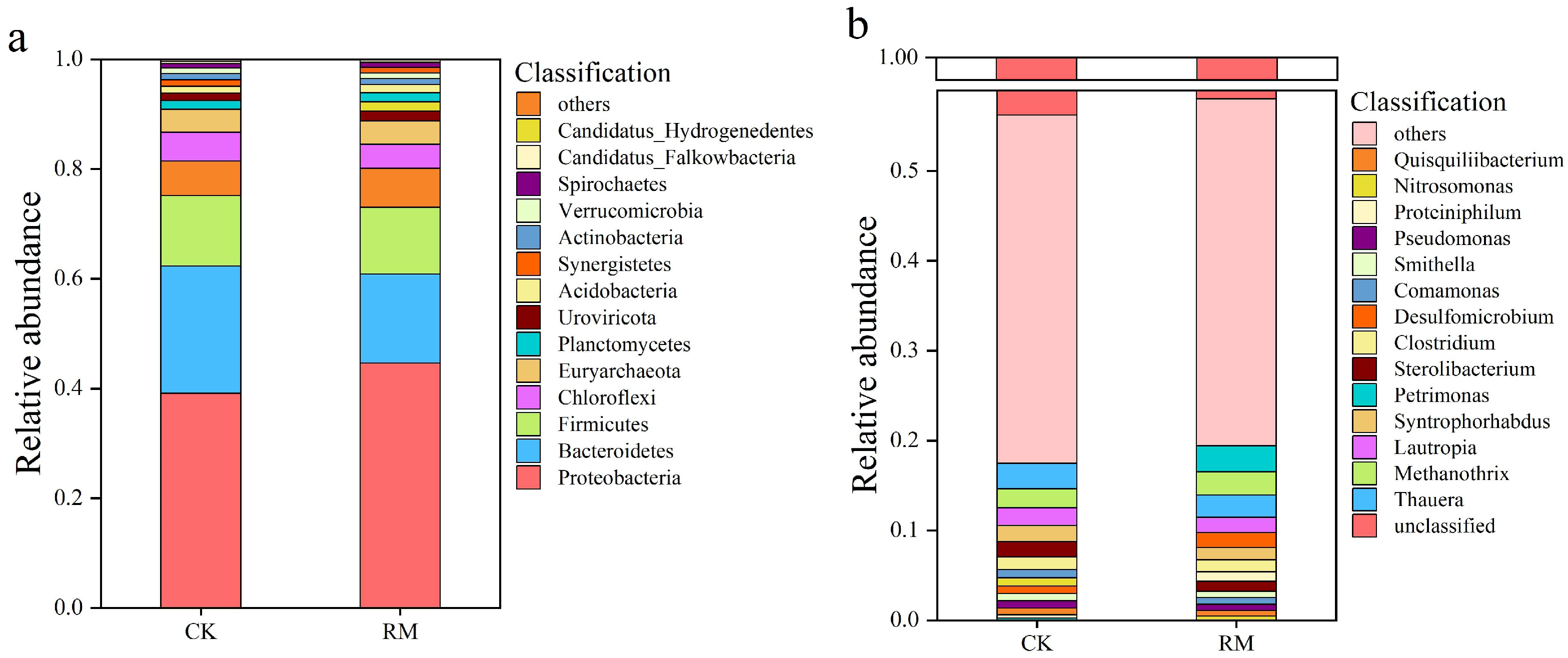
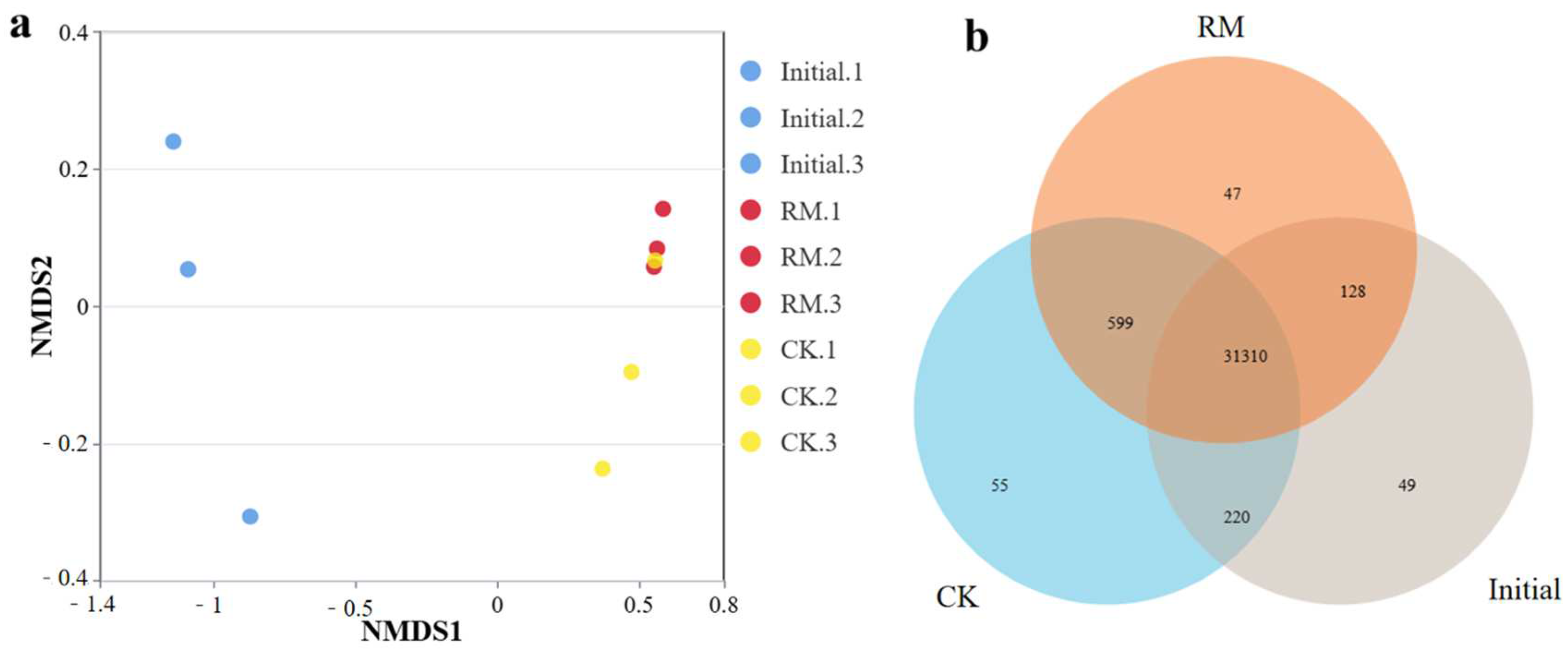
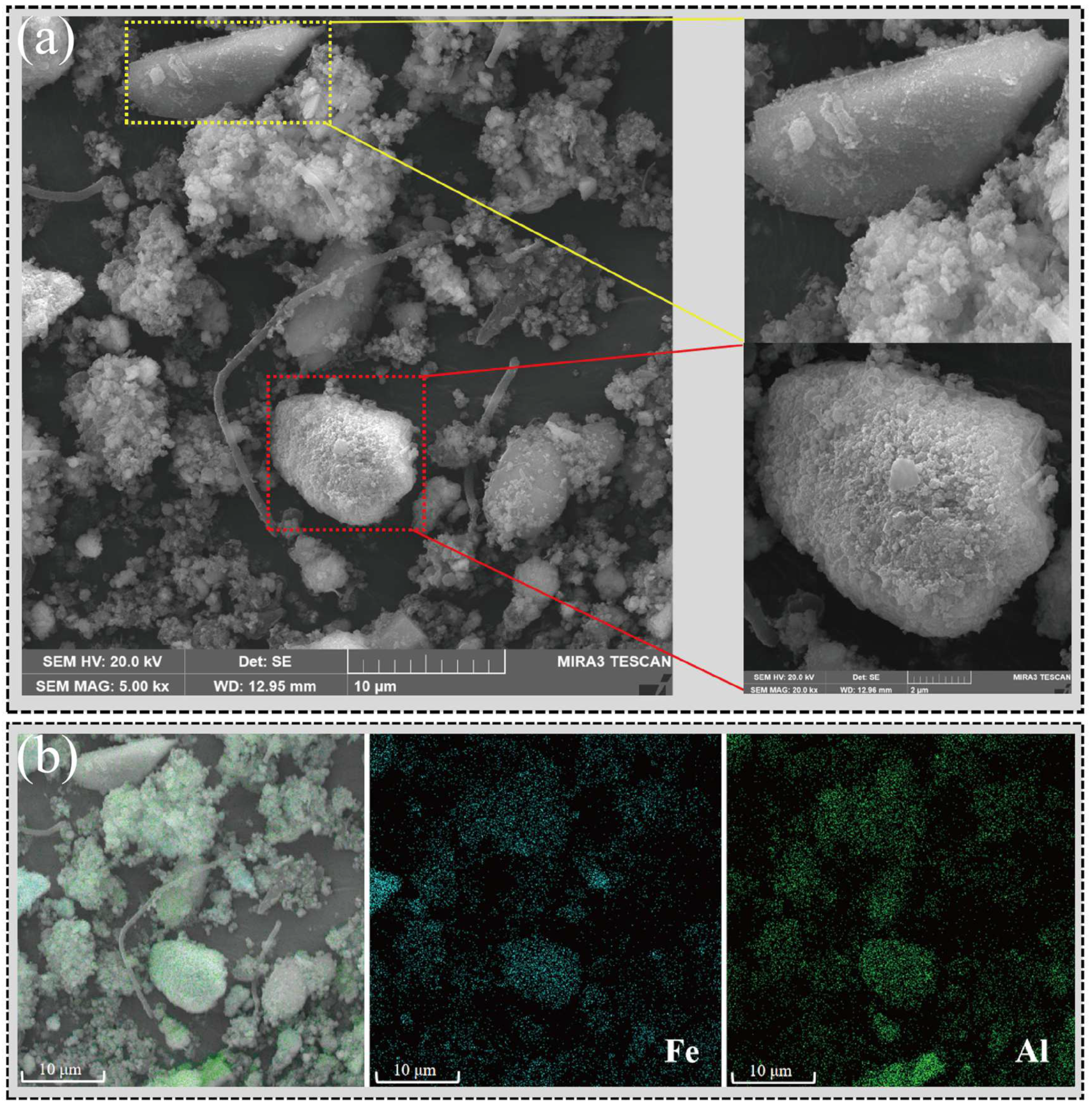
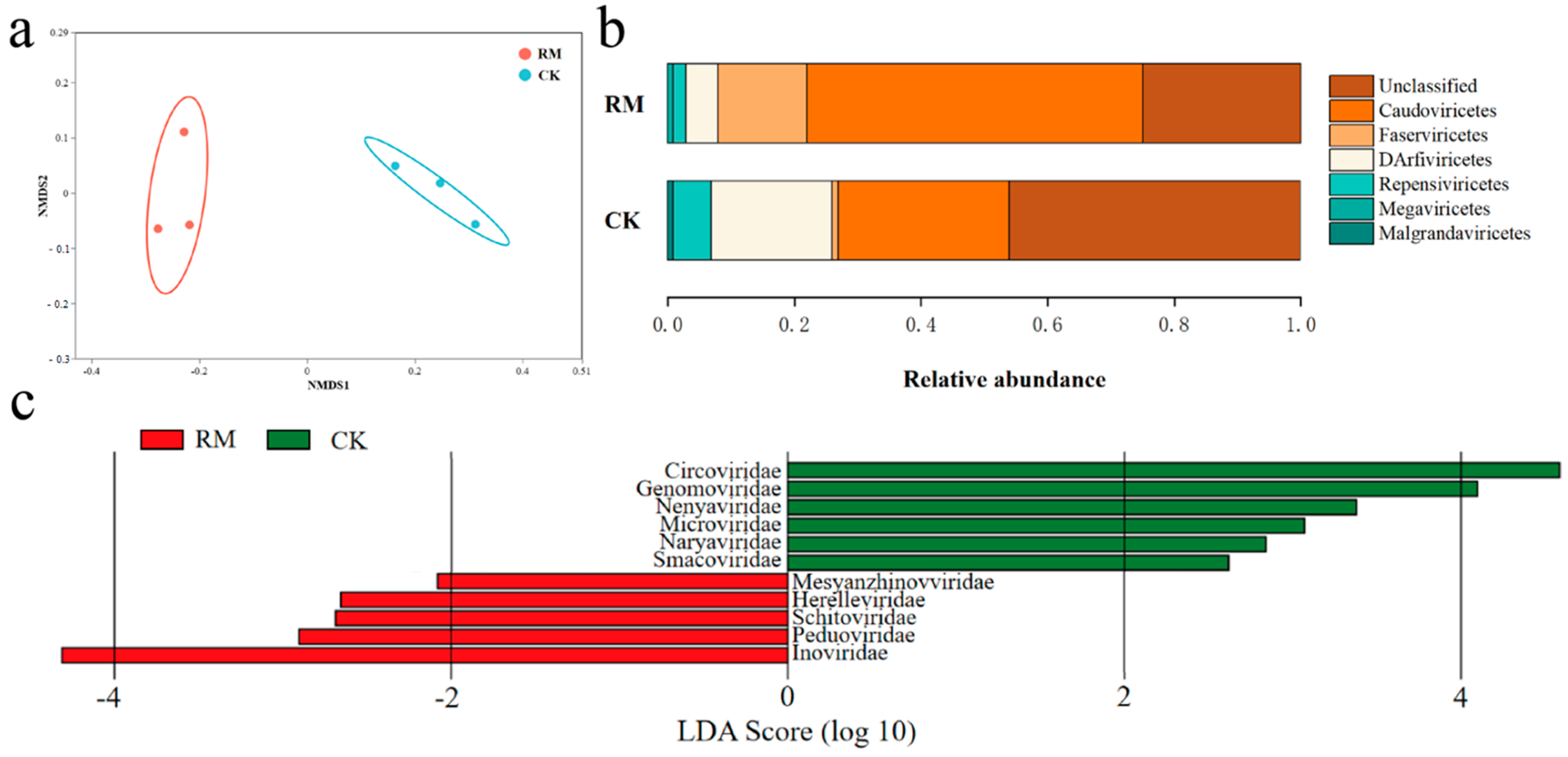
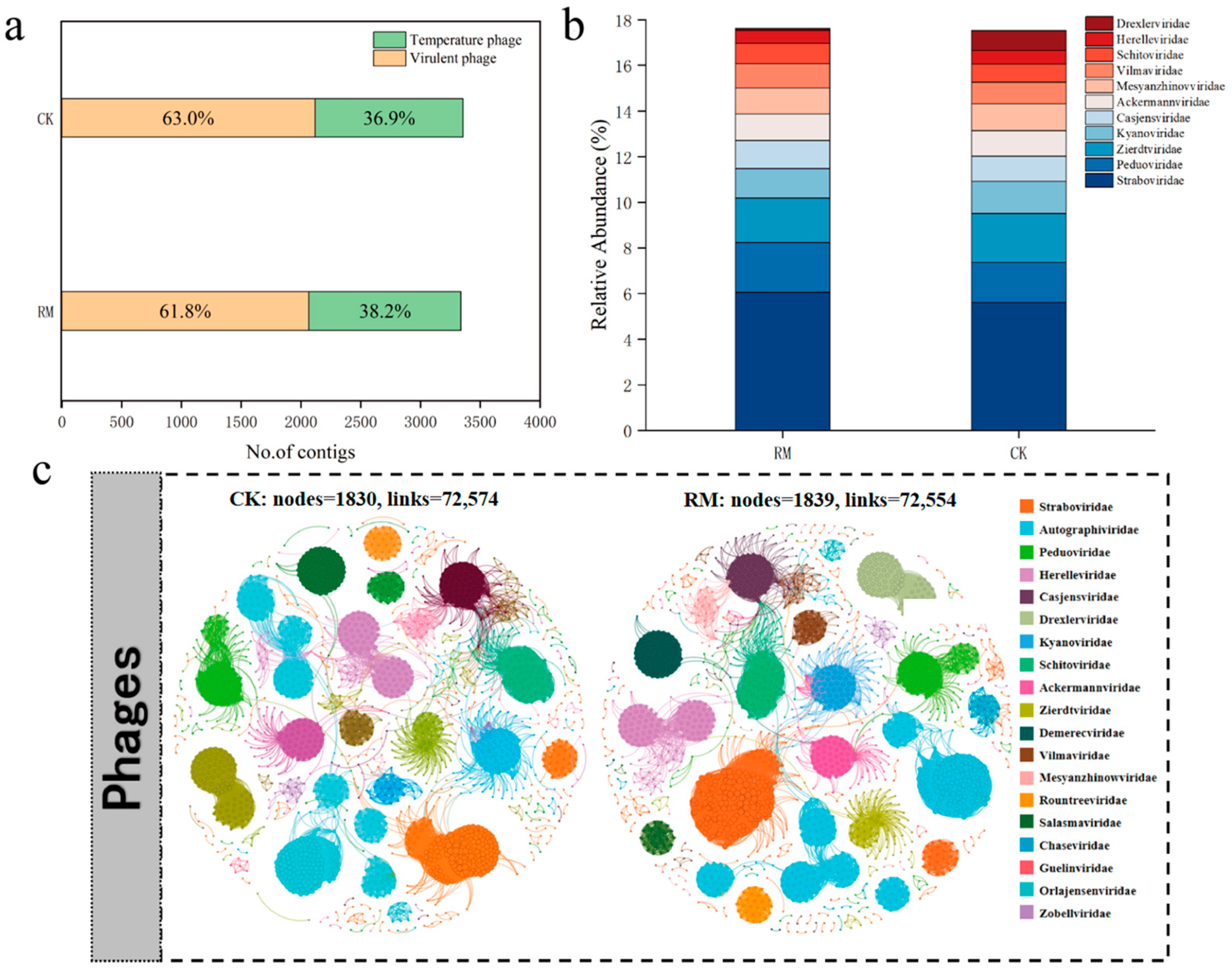
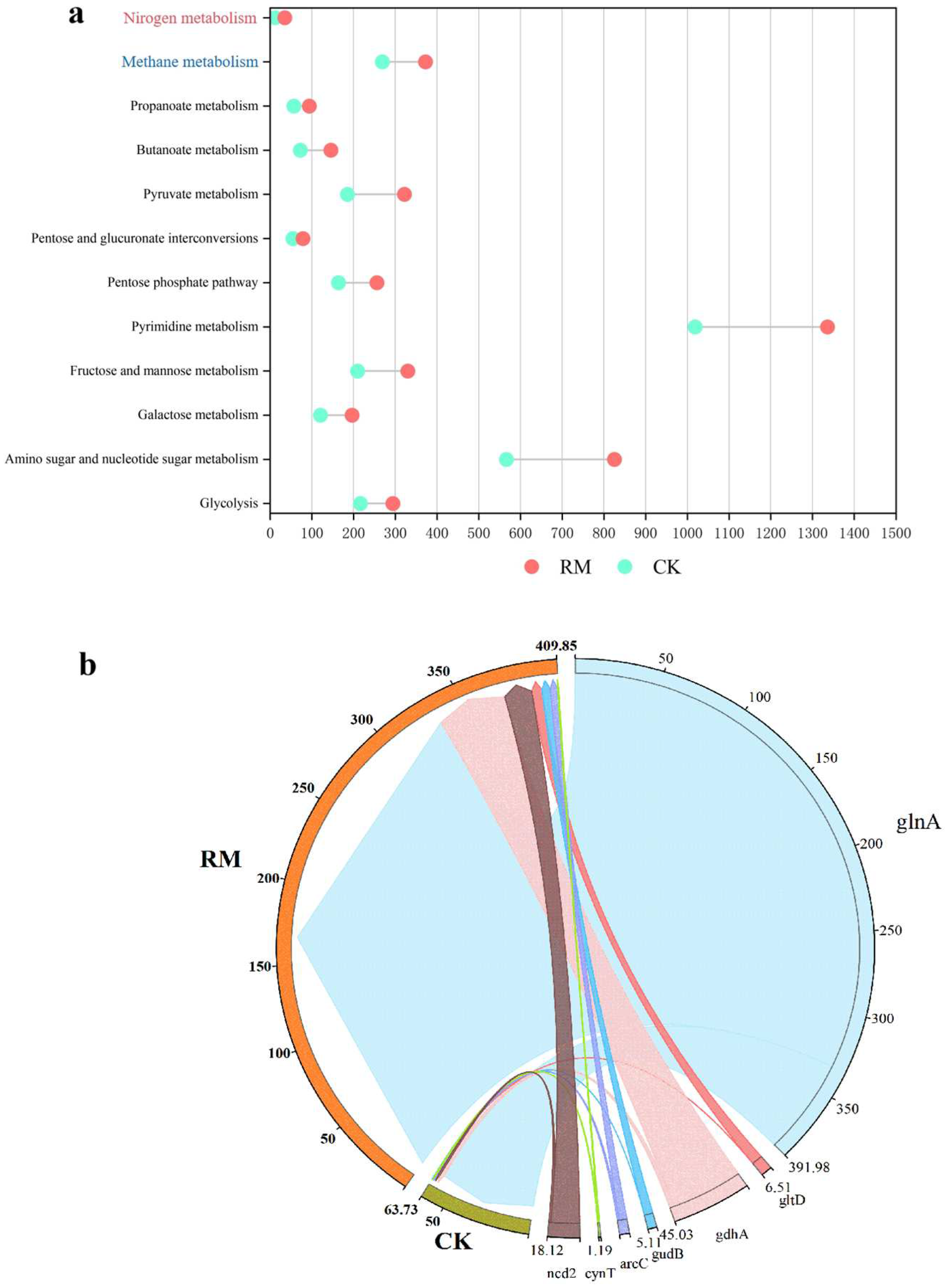
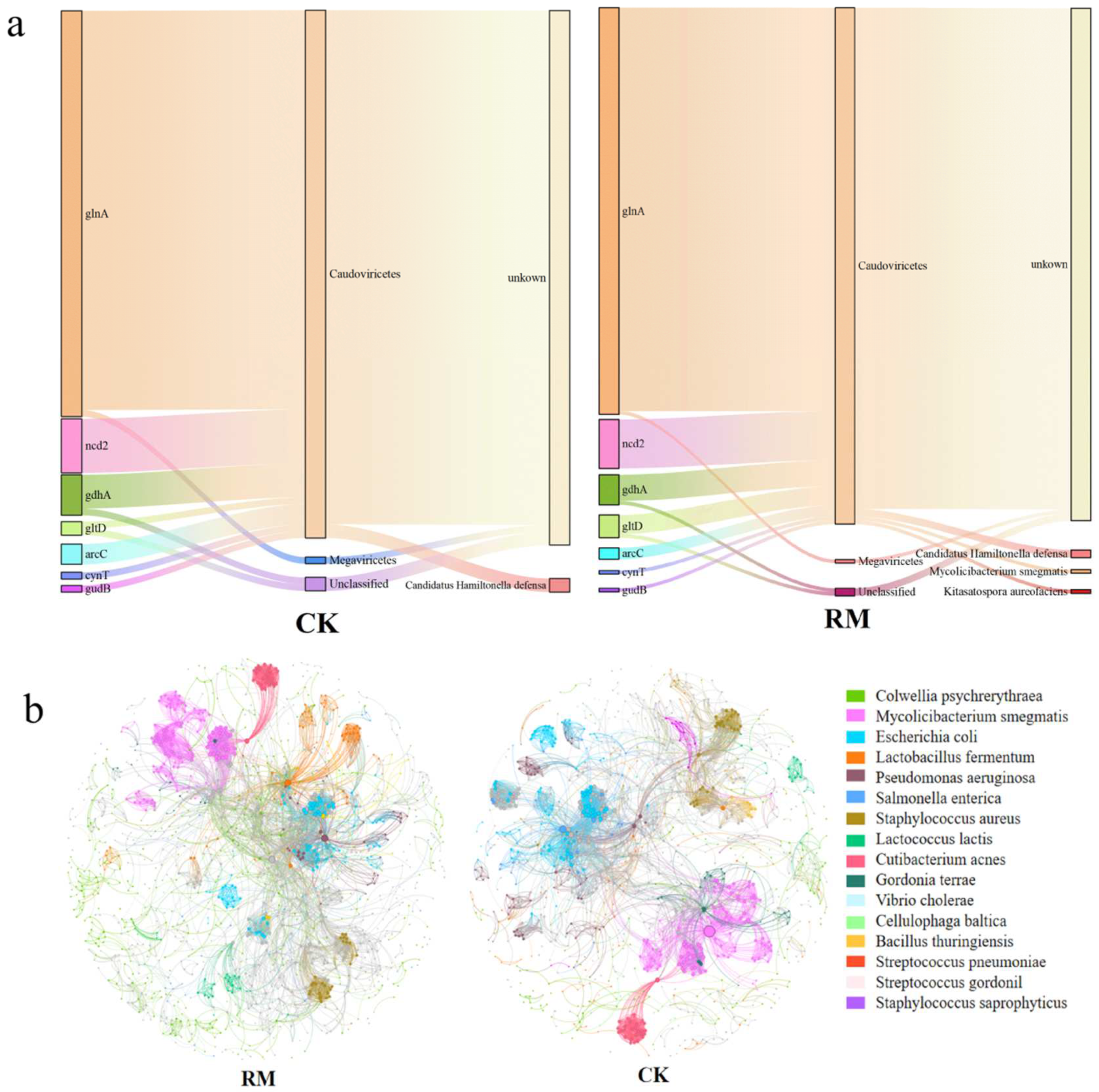
Disclaimer/Publisher’s Note: The statements, opinions and data contained in all publications are solely those of the individual author(s) and contributor(s) and not of MDPI and/or the editor(s). MDPI and/or the editor(s) disclaim responsibility for any injury to people or property resulting from any ideas, methods, instructions or products referred to in the content. |
© 2025 by the authors. Licensee MDPI, Basel, Switzerland. This article is an open access article distributed under the terms and conditions of the Creative Commons Attribution (CC BY) license (https://creativecommons.org/licenses/by/4.0/).
Share and Cite
Peng, Y.; Jiang, L.; Wu, J.; Yang, J.; Guo, Z.; Miao, M.; Peng, Z.; Chang, M.; Miao, B.; Liu, H.; et al. Red Mud Potentially Alleviates Ammonia Nitrogen Inhibition in Swine Manure Anaerobic Digestion by Enhancing Phage-Mediated Ammonia Assimilation. Microorganisms 2025, 13, 690. https://doi.org/10.3390/microorganisms13030690
Peng Y, Jiang L, Wu J, Yang J, Guo Z, Miao M, Peng Z, Chang M, Miao B, Liu H, et al. Red Mud Potentially Alleviates Ammonia Nitrogen Inhibition in Swine Manure Anaerobic Digestion by Enhancing Phage-Mediated Ammonia Assimilation. Microorganisms. 2025; 13(3):690. https://doi.org/10.3390/microorganisms13030690
Chicago/Turabian StylePeng, Yulong, Luhua Jiang, Junzhao Wu, Jiejie Yang, Ziwen Guo, Manjun Miao, Zhiyuan Peng, Meng Chang, Bo Miao, Hongwei Liu, and et al. 2025. "Red Mud Potentially Alleviates Ammonia Nitrogen Inhibition in Swine Manure Anaerobic Digestion by Enhancing Phage-Mediated Ammonia Assimilation" Microorganisms 13, no. 3: 690. https://doi.org/10.3390/microorganisms13030690
APA StylePeng, Y., Jiang, L., Wu, J., Yang, J., Guo, Z., Miao, M., Peng, Z., Chang, M., Miao, B., Liu, H., Liang, Y., Yin, H., He, Q., & Liu, X. (2025). Red Mud Potentially Alleviates Ammonia Nitrogen Inhibition in Swine Manure Anaerobic Digestion by Enhancing Phage-Mediated Ammonia Assimilation. Microorganisms, 13(3), 690. https://doi.org/10.3390/microorganisms13030690







